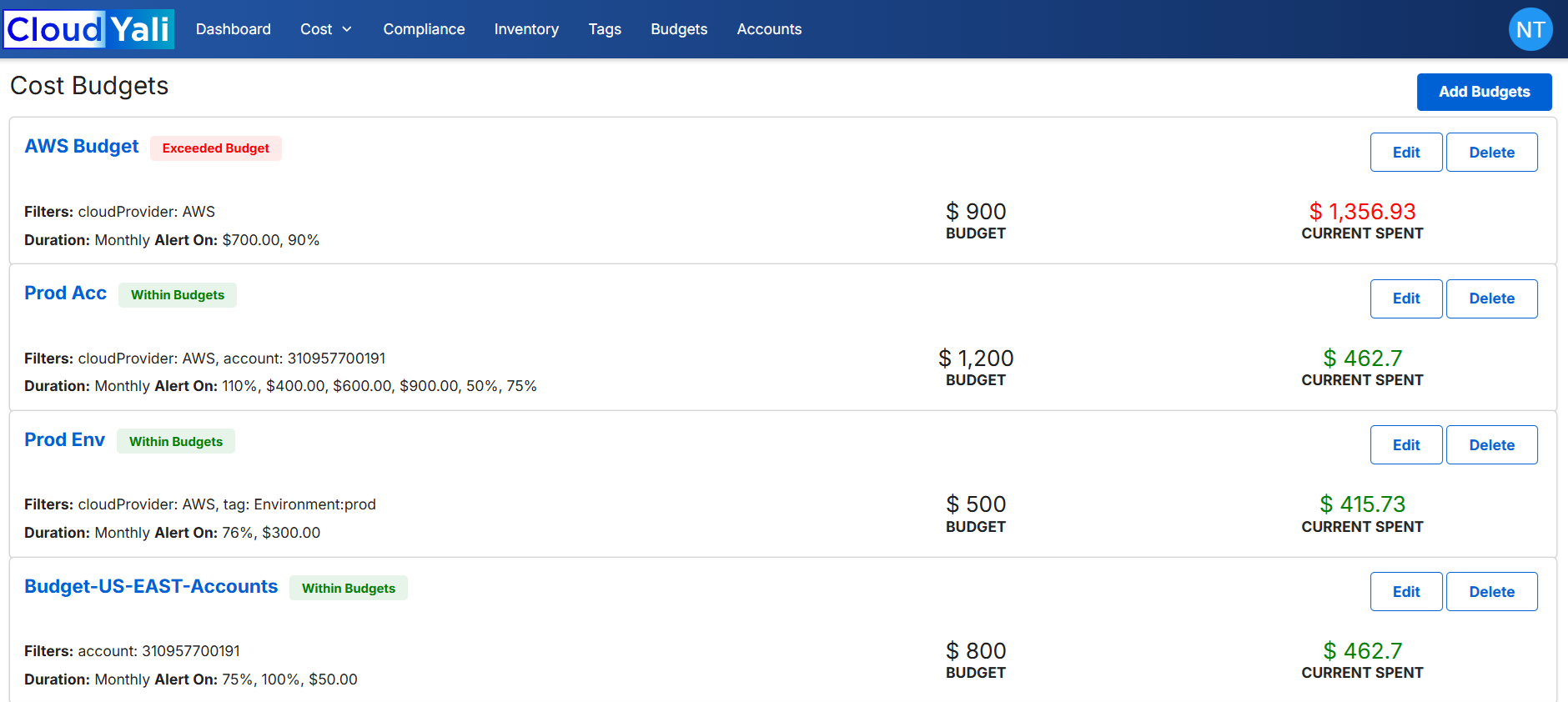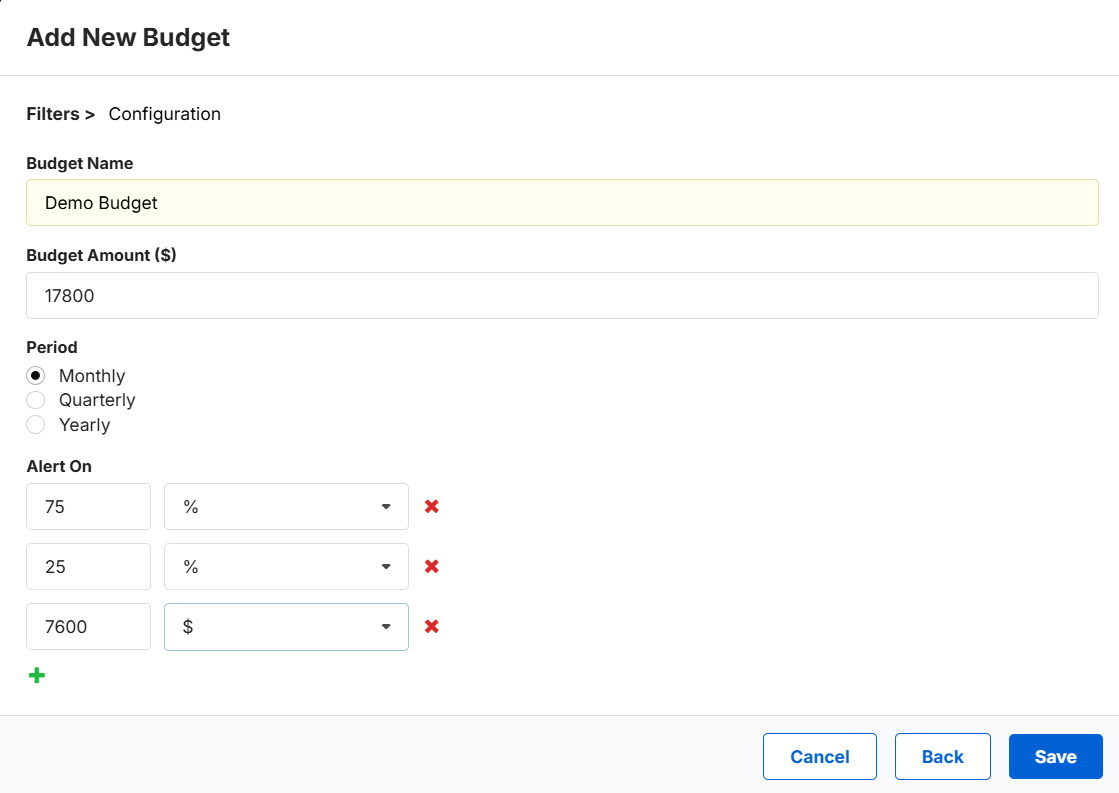Setting Up Budget Alerts
Managing your cloud costs effectively is crucial in today's dynamic cloud environment. CloudYali's Budget Alerts feature empowers you to monitor and control your spending across AWS and GCP with precision. This guide provides detailed steps to help you set up budget alerts tailored to your organization's needs.
Prerequisites
Before you begin, ensure you have:
- An active CloudYali account.
- Access permissions to create budgets and alerts within CloudYali.
- Connected your AWS and/or GCP accounts to CloudYali. For more information on how to onboard your AWS account, please refer to AWS Onboarding Guide.
Step-by-Step Guide to Setting Up Budget Alerts
Step 1: Navigate to Budgets Section
-
Access the Budgets Page
- From the main navigation menu, click on "Budgets"
- This will take you to the Cost Budgets dashboard where you can view all your existing budgets

Step 2: Create a New Budget
-
Initiate Budget Creation
- Click the "Add Budgets" button in the top-right corner of the screen
- This will open the budget creation wizard
-
Configure Budget Filters
The first step in creating a budget is to set up filters that define its scope. You can select from the following filter types:
- Cloud Provider: Select one or more cloud providers (AWS, GCP) that this budget will monitor
- Account: Filter by specific AWS accounts or GCP projects
- Region: Limit the budget to specific cloud regions
- Service: Target specific cloud services (like EC2, S3, Compute Engine)
- Tags: Apply tag-based filters using key-value pairs (e.g., CostCenter:Prod)
You can add multiple filters by clicking the "Add Filter" button:

-
Click "Next" to proceed to budget configuration
Step 3: Configure Budget Details
-
Define Budget Parameters

- Budget Name: Enter a descriptive name for your budget
- Budget Amount ($): Specify the total budget amount in dollars
- Period: Select the budget cycle (Monthly, Quarterly, or Yearly)
- The budget amount will reset automatically at the end of each period
- Monthly budgets reset at the end of each calendar month
- Quarterly budgets reset every three months
- Yearly budgets reset at the end of each calendar year
-
Set Up Alert Thresholds
- Click the "+" button to add alert thresholds
- Configure each threshold with:
- A numeric value
- Type (% of budget or absolute $ amount)
- Add multiple thresholds to receive alerts at different spending levels
- For each threshold you add, you'll receive email notifications when your spending reaches that level
Note: An alert is triggered each time a threshold is reached. For example, if you set thresholds at 50%, 75%, and 100%, you'll receive separate email notifications when your spending reaches each of these levels.
-
Click "Save" to create your budget
Step 4: Manage Your Budgets
-
View Budget Status
- Return to the Cost Budgets dashboard to see all your budgets
- Monitor the current spend versus budgeted amount for each budget
- Check which budgets have exceeded their limits or are approaching thresholds
- For information on how to edit or delete budgets, see Managing Existing Budgets
Budget Filter Examples
Example 1: Cloud Provider-Specific Budget
Use Case: Track all spending on AWS resources
Filter Configuration:
- Cloud Provider: AWS
Example 2: Regional Cost Tracking
Use Case: Monitor spending in specific cloud regions
Filter Configuration:
- Cloud Provider: AWS
- Region: ap-northeast-1, ap-northeast-2
Example 3: Environment-Based Budget
Use Case: Track production environment costs
Filter Configuration:
- Cloud Provider: AWS
- Tag: CostCenter:Prod
Example 4: Service-Specific Budget
Use Case: Monitor compute service costs
Filter Configuration:
- Cloud Provider: AWS
- Service: EC2, Lambda
Best Practices for Budget Alerts
- Start with Broad Budgets: Begin with company-wide budgets, then create more granular budgets as needed
- Align with Financial Cycles: Set budget periods that match your organization's financial reporting cycles
- Use Multiple Thresholds: Configure progressive alerts (e.g., 50%, 75%, 90%, 100%) to receive early warnings
- Tag Resources Consistently: Implement a consistent tagging strategy to enable precise budget filtering
- Review Regularly: Periodically assess and adjust your budgets based on changing business needs
Understanding Budget Alert Emails
When your spending reaches a threshold you've defined, CloudYali sends an automatic email alert that includes:
- Alert Subject: Clearly indicates which budget has exceeded its threshold
- Threshold Details: Shows which threshold has been reached (e.g., 50%, 75%, 100%)
- Budget Overview: Provides a summary of the budget, including:
- Budget name
- Total budget amount
- Current spend
- Budget period
- Visual representation of budget utilization

These email alerts help you stay informed about your cloud spending in real-time, allowing you to take timely action if costs are rising faster than expected.
Need Assistance?
We're here to help you make the most of CloudYali's budget features.
-
Email Support
Reach out to us at support@cloudyali.io for any questions or issues.